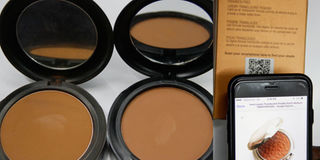How to detect fake cosmetics with an app

A genuine(Left) and a fake beauty product in Nairobi nad right: A genuine product result is shown after a scanning verification. PHOTOS | MARTIN MUKANGU
What you need to know:
- Shops are flooded with imitations that look uncannily similar to popular brand name cosmetics, but with technology, you’ll be able to tell the real thing from the fake.
- Applications have been developed to help consumers tell whether a product is genuine or fake. First, you need to download the app for free from the Google Play Store for Android, and from the Apple App Store on iTunes for iOS and then scan the barcode of the product with the app.
These days, many consumers are fall prey to fake cosmetics masquerading as original brand name products with the packaging and prices to boot. Sellers of imitations are now charging extremely high prices for the products in a bid to convince unsuspecting buyers that the products are indeed authentic.
This psychological trick is used in high-end shops in malls. Counterfeiters target clients of large cosmetic manufactures like L’Oreal, Johnson & Johnson, Fashion Fair, MAC, ELF, Dove, Smash Box, Bobbi Brown and others, by making and selling knockoffs that look uncannily similar to the originals. Imitations are particularly prevalent with online sellers, who explain the cheaper price by claiming that since they have fewer operating expenses than brand name shops, they can afford to sell “genuine” products at a slightly cheaper price.
Fakes are now packaged in a way that will fool even the most experienced eye, which leaves one to wonder how one can distinguish between genuine products and the equally pricey imitations. That’s where technology comes in. With a little effort and the help of an app, you do not have to fall victim to fake products, which often contain banned ingredients such as lead, copper, mercury, arsenic and cadmium.
According to an article in the Daily Mail, after tests, fake MAC eyeliner was found to contain 46 times the level of copper permitted. Ultimately, it all ends up being about your health. It is best to save up for a few genuine brands, rather than using imitations. And when you do, you should be careful to get the real product. Luckily, free
Applications have been developed to help consumers tell whether a product is genuine or fake. First, you need to download the app for free from the Google Play Store for Android, and from the Apple App Store on iTunes for iOS and then scan the barcode of the product with the app.
After you scan, some information on the company, name of product, batch number, expiry date and other relevant details will be displayed. If the product is fake, the app will not display any information.
******
QUICK FIXES
Other ways to detect fakes:
Pricing: If the price is too low as compared to the brand prices, it is fake.
Poor grammar and typos on expensive packaging.
Low quality applicators.
Look carefully at the fonts used on the packaging. Genuine companies have their own patented fonts which are not accessible to outsiders.
Most fake products do not have a barcode, batch number or expiry date.
Differences in scent.
Original products do not come cheap, so if you are planning to buy genuine cosmetics, here is what different budgets will get you:
Sh5, 000 to Sh8, 000 will get you moisturiser, primer, concealer, foundation, powder, eye shadow, blusher, eye pencil, mascara and a couple of lipsticks from brands like Sleek, Black Opal, Revlon, Maybelline, Tara and Suzie Beauty.
Sh10, 000 to Sh50, 000 will buy you brands like MAC, Clinique and Iman.
*******
ASK IRENE
Do I always have to buy brand name cosmetics or are there alternatives that are affordable and safe?
– Cathy, Nairobi.
You can use drugstore lip gloss and face powder as these are made from harmless oils and clays.




